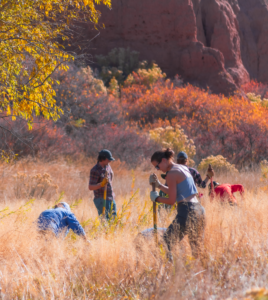
As environmental challenges continue to pose threats to the world, collaboration is key to creating solutions that can help build climate change resilience and adaptation.
Collaborative partnerships between Colorado State University and local environmental organizations are vital to successful restoration projects. Ecological restoration aims to initiate or accelerate the recovery of an ecosystem that has been disturbed, often by phenomena like fire, flooding, damming rivers or over-grazing.
Students in the Warner College of Natural Resources have the opportunity to develop their restoration skills on “restoration workdays.” Rick Knight, professor emeritus in the Department of Human Dimensions of Natural Resources, introduced the workdays when he began his career at CSU almost 40 years ago.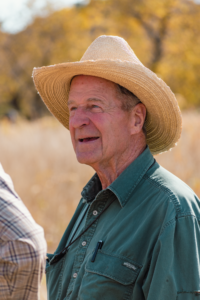
“The workdays started with classes I taught and with student organizations I’ve been advising, including the chapter of the Society for Conservation Biology and Backcountry Hunters and Anglers,” Knight said. “Other student organizations, like The Wildlife Society and The Society for Ecological Restoration, have asked if they could attend and I’ve always said, ‘YES!’”
Since their introduction, restoration workdays have only grown in popularity. The Warner College started collaborating with the Front Range Community College’s Forestry, Wildlife and Natural Resources Program and the Wildlands Restoration Volunteers to expand the project’s impacts. As many as 50 students attend restoration workdays.
“We want to get students connected to the landscape and give them an opportunity to learn outside the classroom,” added Heather Dannahower, a professor in the FRCC Forestry, Wildlife and Natural Resources Program.
Students, faculty, staff and alumni are invited to gather for restoration workdays on multiple Saturdays throughout the year to improve degraded lands in and around Fort Collins. The projects range widely, from restoring wildlife-friendly fence crossings to removing invasive plants.
Restoration Workday at The Roberts Ranch
In October, students traveled to The Roberts Ranch, a nearly 17,000-acre ranch in Livermore, Colorado. The Roberts Ranch is permanently protected by a conservation easement, which prohibits activities such as mining or building. While the Ranch does have a legal foundation to protect its land, soil erosion still poses a problem along a creek that runs through the property. 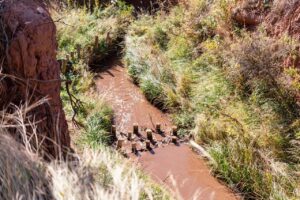
To address this issue, students from CSU and FRCC, as well as the CSU chapters of SER, TWS and the BHA collaborated with WLRV.
“This creek is a major water source for the whole ranch, but the creek bed has dropped 40 feet below the rest of the ranch because of soil erosion,” explained Nate Boschmann, a program manager at WLRV.
Students broke into teams to build or repair beaver dam analogs, called whicker weaves, which are human-made structures designed to mimic the form and function of a natural dam built by a beaver.
Beaver dams are natural filters for creeks and streams. Once in place, they catch sediment floating in the water and allow it to settle on the stream bed, slowly raising the stream over time. While natural dams are generally more effective at reversing erosion, not every habitat is suitable for beavers.
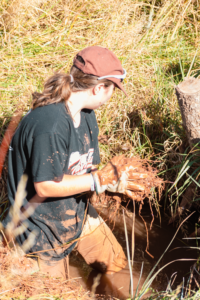
WLRV are hopeful that with the expansion of the beaver analog dams, they’ll soon be able to reintroduce willows and cottonwoods, and, eventually, beavers to the property.
“We are building a beaver habitat and wet meadow restoration program that I believe is our best hope of having a meaningful impact on climate change resilience in our region,” Boschmann said.
Students took sections of mud and grass called “plugs” from the creek’s edge to build on the beaver dam analogs. While some students found themselves waist-deep in the creek, fortifying the beaver dam analogs already in place, others stayed dry and moved logs, rocks and dirt downstream to help build new ones.
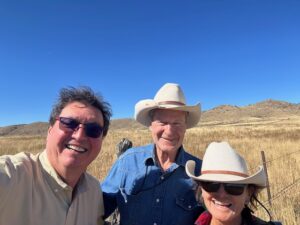
“Offering more experiential learning opportunities — just like these workdays — to our students is a priority here at Warner,” said Warner College’s Dean A. Alonso Aguirre who participated in this October workday. “Getting students directly into the field gives them memorable experiences, valuable connections and hands-on preparation for jobs within the natural resources industry.”
The experience of applying and advancing skills outside of the classroom is a major draw for the students who join the restoration workdays.
“Attending restoration workdays has given me motivation and provided me with an outlet to dig deeper into my academics. Through our hands-on work at the Ranch, I found that conservation and empathy are intertwined,” said Kay Rampelt, a student in HDNR.
“For one of the few, or first, times in their lives, students are outdoors giving back to land health with tools and skills they are learning, all while developing friendships with peers they’ve only known in classrooms,” Knight said. “I’ve never seen them come alive in any other setting like they do when they’re outside, helping heal degraded lands and waters.”